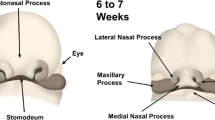Abstract
Developmental nasal midline masses in children are rare lesions. Neuroimaging is essential to characterise these lesions, to determine the exact location of the lesion and most importantly to exclude a possible intracranial extension or connection. Our objective was to evaluate CT and MRI in the diagnosis of developmental nasal midline masses. Eleven patients (mean age 4.5 years) with nasal midline masses were examined by CT and MRI. Neuroimaging was evaluated for (a) lesion location/size, (b) indirect (bifid or deformed crista galli, widened foramen caecum, defect of the cribriform plate) and direct (identification of intracranially located lesion components or signal alterations) imaging signs of intracranial extension, (c) secondary complications and (d) associated malformations. Surgical and histological findings served as gold standard. Nasal dermoid sinus cysts were diagnosed in 9 patients. One patient was diagnosed with an meningocele and another patient with a nasal glioma. Indirect CT and MRI signs correlated with the surgical results in 10 of 11 patients. Direct CT findings correlated with surgery in all patients, whereas the direct MRI signs correlated in 9 of 11 patients. In 2 patients MRI showed an intracranial signal alteration not seen on CT. Neuroimaging corrected the clinical diagnosis in 1 patient. One child presented with a meningitis. In none of the patients was an associated malformation diagnosed. Intracranial extension is equally well detected by CT and MRI using indirect imaging signs. Evaluating the direct imaging signs, MRI suspected intracranial components in 2 patients without a correlate on CT. This could represent an isolated intracranial component that got undetected on CT and surgery. In 9 patients CT and MRI matched the surgical findings. The MRI did not show any false-negative results. These results in combination with the multiplanar MRI capabilities, the different image contrasts that can be generated by MRI and the lack of radiation favour the use of MRI as primary imaging tool in these young patients in which the region of imaging is usually centred on the radiosensitive eye lenses.




Similar content being viewed by others
References
Pratt LW (1965) Midline cysts of the nasal dorsum: embryologic origin and treatment. Laryngoscope 75:968–980
Hughes GB, Sharpino G, Hunt W, Tucker HM (1980) Management of the congenital midline nasal mass: a review. Head Neck Surg 2:222–233
Paller AS, Pesnler JM, Tomita T (1991) Nasal midline masses in infants and children. Laryngoscope 107:795–800
Harley EH (1991) Pediatric congenital nasal masses. Ear Nose Throat J 70:28–32
Morgan DW, Evans JN (1990) Developmental nasal anomalies. J Laryngol Otol 104:394–403
Barkovich AJ, Vandermarck P, Edwards MS, Cogen PH (1991) Congenital nasal masses: CT and MR imaging fetaures in 16 cases. Am J Neuroradiol 12:105–116
Zerris VA, Annino D, Heilman CB (2002) Nasofrontal dermoid sinus cyst: report of two cases. Neurosurgery 51:811–814
Paller AS, Pensler JM, Tomita T (1991) Nasal midline masses in infants and children: dermoids, encephaloceles, and gliomas. Arch Dermatol 127:362–366
Hoving EW (2000) Nasal encephaloceles. Childs Nerv Syst 16:702–706
Fornadley JA, Tami TA (1989) The use of magnetic resonance imaging in the diagnosis of the nasal dermal sinus-cyst. Otolaryngol Head Neck Surg 101:397–398
Posnick JC, Bortoluzzi P, Armstrong DC, Drake JM (1994) Intracranial nasal dermoid sinus cysts: computed tomographic scan findings and surgical results. Plast Reconstr Surg 93:745–754
Lindbichler F, Braun H, Raith J, Ranner G, Kugler C, Uggowitzer M (1997) Nasal dermoid cyst with a sinus tract extending to the frontal dura mater: MRI. Neuroradiology 39:529–531
Burrows PE, Laor T, Paltiel H, Robertson RL (1998) Diagnostic imaging in the evaluation of vascular birthmarks. Dermatol Clin 16:455–488
Rouev P, Dimov P, Shomov G (2001) A case of nasal glioma in a new-born infant. Int J Pediatr Otorhinolaryngol 58:91–94
Jartti PH, Jartti AE, Karttunen AI, Paakko EL, Herva RL, Pirila TO (2002) MR of a nasal glioma in a young infant. Acta Radiol 43:141–143
Verney Y, Zanolla G, Teixeira R, Oliveira LC (2001) Midline nasal mass in infancy: a nasal glioma case report. Eur J Pediatr Surg 11:324–327
Oddone M, Granata C, Dalmonte P, Biscaldi E, Rossi U, Toma P (2002) Nasal glioma in an infant. Pediatr Radiol 32:104–105
Schlosser RJ, Faust RA, Phillips CD, Gross CW (2002) Three-dimensional computed tomography of congenital nasal anomalies. Int J Pediatr Otorhinolaryngol 65:125–131
Bloom DC, Cavalho DS, Dory C, Brewster DF, Wickersham JK, Kearns DB (2002) Imaging and surgical approach of nasal dermoids. Int J Pediatr Otorhinolaryngol 62:111–122
Denoyelle F, Ducroz V, Roger G, Garabedian EN (1997) Nasal dermoid sinus cysts in children. Laryngoscope 107:795–800
Hoeger PH, Schaefer H, Ussmueller J, Helmke K (2001) Nasal glioma presenting as capillary haemangioma. Eur J Pediatr 160:84–87
Loke DKT, Woolford TJ (2001) Open septorhinoplasty approach for the excision of a dermoid cyst and sinus with primary dorsal reconstruction. J Laryngol Otol 115:657–659
Bilkay U, Gundogan H, Ozek C, Tokat C, Gurler T, Songur E, Cadg A (2001) Nasal dermoid sinus cysts and the role of open rhinoplasty. Ann Plast Surg 47:8–14
Pensler JM, Bauer BS, Naidich TP (1988) Craniofacial dermoids. Plast Reconstr Surg 82:953–958
Brydon HL (1992) Intracranial dermoid cysts with nasal dermal sinuses. Acta neurochir (Wien) 118:185–188
Wardinsky TD, Pagon RA, Kropp RJ, Hayden PW, Clarren SK (1991) Nasal dermoid sinus cysts: association with intracranial extension and multiple malformations. Cleft Palate Craniofac J 28:87–95
Rapport RL II, Dunn RC Jr, Alhady F (1981) Anterior encephalocele. J Neurosurg 54:213–219
Author information
Authors and Affiliations
Corresponding author
Rights and permissions
About this article
Cite this article
Huisman, T.A.G.M., Schneider, J.F.L., Kellenberger, C.J. et al. Developmental nasal midline masses in children: neuroradiological evaluation. Eur Radiol 14, 243–249 (2004). https://doi.org/10.1007/s00330-003-2008-3
Received:
Revised:
Accepted:
Published:
Issue Date:
DOI: https://doi.org/10.1007/s00330-003-2008-3




